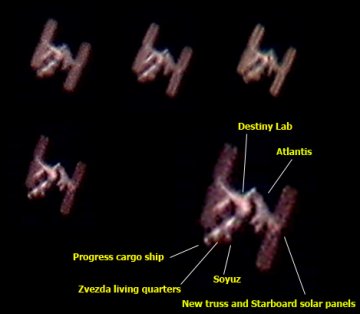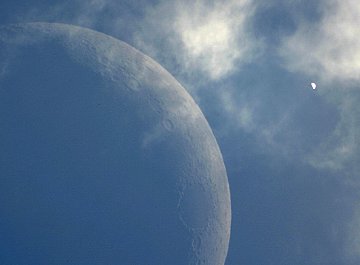 Where's Saturn? Is that a UFO--or the ISS? What's the name of that star? Get the answers from mySKY--a fun new astronomy helper from Meade. Where's Saturn? Is that a UFO--or the ISS? What's the name of that star? Get the answers from mySKY--a fun new astronomy helper from Meade. SPACESHIP SIGHTINGS: Space shuttle Atlantis undocked from the International Space Station (ISS) this morning, and tonight the pair will fly in tandem over many US towns and cities. The two spacecraft will appear as distinct points of light, first the ISS followed by the shuttle. When should you look? There are two ways to find out: Sign up for flyby alerts from Spaceweather PHONE or check the flyby time tables at Heavens Above. CORRECTION: Earlier we reported that Atlantis would lead the ISS across the sky. In fact, the reverse will occur: ISS comes first, followed by Atlantis. Apologies for the mix-up. SPACESHIP SIGHTINGS II: Last night, just hours before undocking, ISS and Atlantis flew over Renton, Washington. "It was my last chance to see them together before Atlantis comes home," says amateur astronomer Tom Gwilym who took these pictures through his hand-guided 12-inch Meade LX200: 
Tom's images show the station's new solar arrays, which were unfurled by the crew of Atlantis during their 9-day construction mission to the ISS. The new arrays not only add power to the ISS, they also make the station bigger and easier to see from the ground. If the ISS glides over your hometown tonight, try looking at it through your backyard telescope. The view is out of this world. DAYTIME ECLIPSE OF VENUS: "It was a race with the clouds, and I won!" says Peter Heinzen of Wallis, Switzerland, who yesterday snapped this picture of Venus emerging from eclipse behind the crescent moon: 
Photo details: Canon EOS 20D, 1/500 seconds, 100 ASA
The eclipse--a.k.a. "lunar occultation"--was visible from Europe, the Middle East and India. Even in broad daylight, people could see it with their unaided eyes. Telescopes trained on the Moon's limb revealed the crescent shape of Venus in close proximity to lunar mountains and craters. "It was a great view!" says photographer Günther Strauch of Borken, NRW, Germany. Browse the gallery for more: Eclipse of Venus Photo Gallery
Updated June 19, 2007 | 
